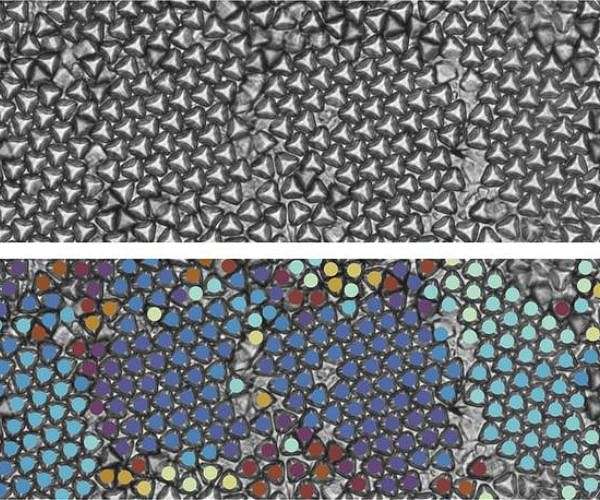
Stanford revolutionizing material science wih shapeshifting nanoparticles
by Clarence Oxford
Los Angeles CA (SPX) Mar 26, 2024
Stanford University researchers have pioneered the use of 3D nanoprinting to create nanoparticles that could usher in a new era of shapeshifting materials. The research, led by Assistant Professor Wendy Gu of the mechanical engineering department, focuses on the fabrication of Archimedean truncated tetrahedrons (ATTs), a geometric shape long theorized to have significant phase-changing capabilities but has been elusive due to fabrication challenges.
Gu’s team has successfully nanoprinted tens of thousands of these particles, which self-assemble into crystal structures with the potential for rapid state changes. These transformations are akin to how tempered steel is produced or how digital storage media retain data. The implications of mastering such phase transitions are vast, promising innovations in engineering and materials science.
Archimedean truncated tetrahedrons, known for their phase-shifting potential, have been difficult to produce outside of computer simulations. Gu’s team, utilizing 3D nanoprinting, has not only achieved production but also demonstrated the practical applications of these particles. By precisely controlling their shape, the team has unlocked new geometric structures with valuable physical properties.
The research highlights two distinct geometric arrangements of ATTs: a hexagonal pattern resembling a nanoscale mountain range and a quasi-diamond structure likened to eggs in a carton. The latter, especially, is a sought-after configuration in photonics, opening up numerous scientific avenues.
Future materials leveraging these 3D printed particles could enable rapid, reversible phase changes through external stimuli such as magnetic fields or electric currents. Gu envisions applications ranging from energy-efficient solar panel coatings to innovative computer memory solutions. Ongoing work aims to imbue these nanoparticles with magnetic properties, further expanding their utility.
Gu’s research, detailed in Nature Communications, marks a significant step forward in the practical application of phase-changing materials, with the potential to impact various fields from energy to computing.
Research Report:Direct observation of phase transitions in truncated tetrahedral microparticles under quasi-2D confinement
Related Links
Stanford University
Space Technology News – Applications and Research
- SEO Powered Content & PR Distribution. Get Amplified Today.
- PlatoData.Network Vertical Generative Ai. Empower Yourself. Access Here.
- PlatoAiStream. Web3 Intelligence. Knowledge Amplified. Access Here.
- PlatoESG. Carbon, CleanTech, Energy, Environment, Solar, Waste Management. Access Here.
- PlatoHealth. Biotech and Clinical Trials Intelligence. Access Here.
- Source: https://www.spacedaily.com/reports/Revolutionizing_Material_Science_Stanfords_breakthrough_in_Shapeshifting_Nanoparticles_999.html
- :has
- :is
- :not
- $UP
- 26
- 3d
- a
- achieved
- aims
- also
- and
- Angeles
- Application
- applications
- ARE
- arrangements
- AS
- Assistant
- avenues
- been
- but
- by
- CA
- capabilities
- challenges
- Changes
- Communications
- computer
- computing
- Configuration
- controlling
- could
- create
- Crystal
- data
- demonstrated
- Department
- detailed
- difficult
- digital
- distinct
- due
- Eggs
- Electric
- enable
- energy
- Engineering
- envisions
- Era
- especially
- expanding
- external
- Fields
- focuses
- For
- Forward
- from
- further
- future
- Have
- Highlight
- highlights
- How
- HTML
- http
- HTTPS
- Impact
- implications
- in
- innovations
- innovative
- into
- jpg
- known
- latter
- Led
- leveraging
- Long
- mar
- Mastering
- material
- materials
- mechanical
- mechanical engineering
- Media
- Memory
- Mountain
- Nature
- New
- news
- numerous
- observation
- of
- on
- ongoing
- only
- opening
- or
- outside
- panel
- Pattern
- phase
- physical
- pioneered
- plato
- Plato Data Intelligence
- PlatoData
- potential
- Practical
- Practical Applications
- precisely
- produce
- Produced
- Production
- Professor
- promising
- properties
- range
- ranging
- rapid
- report
- research
- researchers
- resembling
- retain
- reversible
- Revolutionizing
- s
- Science
- scientific
- Shape
- significant
- simulations
- solar
- solar panel
- Solutions
- spx
- stanford
- Stanford university
- State
- steel
- Step
- storage
- structure
- structures
- Successfully
- such
- team
- Technology
- technology news
- tens
- that
- The
- their
- These
- thousands
- Through
- to
- transformations
- transitions
- two
- under
- university
- unlocked
- use
- usher
- utility
- Utilizing
- Valuable
- various
- Vast
- which
- with
- Work
- zephyrnet












